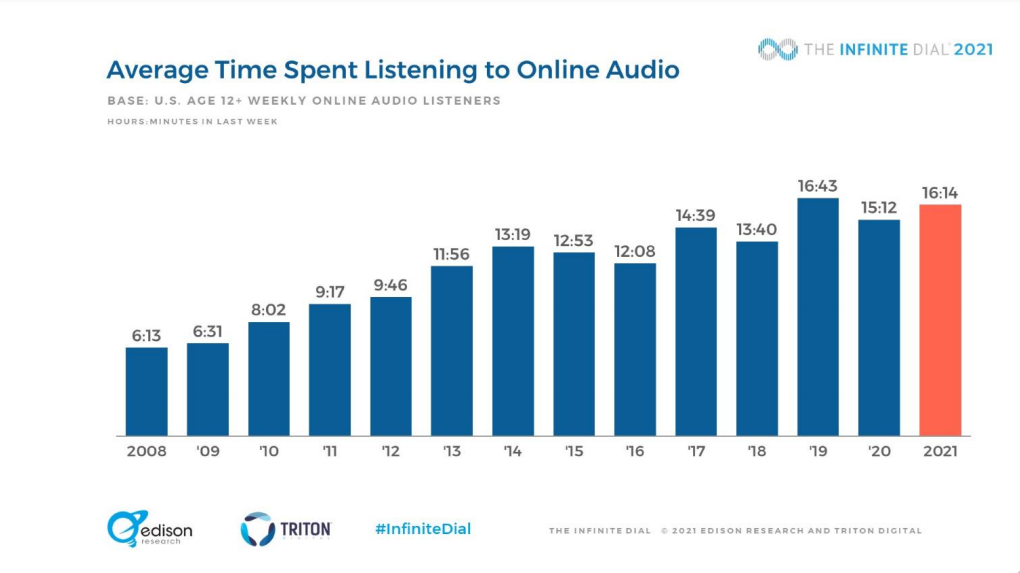
Hot Topics
Time Is Tight
March 23, 2021
The recently unveiled survey results of the Infinite Dial 2021 produced a revealing statistic. The radio industry must acknowledge that we are potentially losing one of our most precious commodities – time.
The annual Infinite Dial studies are a treasure trove of valuable information. One particularly eye-opening statistic was the amount of time consumers spend each week with online audio.
The chart below is alarming:
To be fair, these figures represent ALL on-line audio listening – including the streams of actual, licensed radio stations.
The concerning part is that the over 16 hours of 12+ listening per week dwarfs what we see in most, if not all, PPM markets. This is more representative of what is seen in diary markets. Which makes sense. The Infinite Dial 2021 figure is based on recall, not server-side data. There is nothing wrong with this but we know from comparisons of the methodology used in diary vs. PPM measurement that listening times are greater when using recall.
That, however, is not the point. Even if online users overestimate their actual listening by as much as 50%, terrestrial radio is still losing an enormous number of quarter-hours. That makes for an incredible opportunity.
During the pandemic, we have seen a noticeable decline in AWTE (Time Spent Listening) levels in many PPM markets. These listening losses are more pronounced with the 18-24 and 25-34 age cells. Where is that listening going? According to the Infinite Dial 2021 data, it is going to online platforms. Overwhelmingly, those platforms are not radio station streams. They are primarily Spotify and Pandora.
How does radio get that listening back?
The obvious answer is focusing on online streams. Smart programmers have been doing that for quite some time and will continue to refine those efforts. Stations are also improving their user experience.
It has long been our position that stations should employ Total Line Reporting (TLR). We understand there is a cost factor. One is balancing the revenue loss from the stream with the potential revenue gain from increased ratings. Another is the Nielsen price tag for making your stream “visible” to the meters. We recognize these real-world conditions have a direct impact on the business operations of any station or cluster, so we don’t take this position lightly. One other point for TLR – if you are not paying to have your stream measured, you won’t benefit from the recently introduced PPM Headphone Adjustment (read more on this here).
The other and more pressing problem is this: How do we win back the hearts and minds of listeners and those lost quarter-hours?
That debate is raging at stations everywhere. One thing is clear by this paradigm shift – we will not win in a song-by-song battle. Like many of you, I have the perfect Spotify playlist. I know every song is one I like. And, if I need an instant fix, I can call up whatever song I want – instantly. I know how to do this and I’m a digital immigrant. The younger demos that are tuning away from radio are digital natives. Their use of online platforms is reflexive.
What radio has, and Spotify and their ilk lack, is emotion. Perfect playlists are fine but a bit soulless. There is no companionship. There is no spark. There is just music. This is where our opportunity lies, in taking what playlist platforms lack, and emphasizing what radio delivers.
Radio has demonstrated its capability to form a connection with its fans. As an industry, we need to redouble our efforts on strengthening and advancing those bonds.
The data is on the wall. How will we use it?
-Charlie Sislen, Partner

Comments